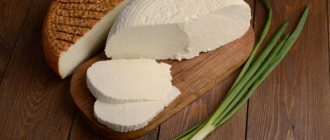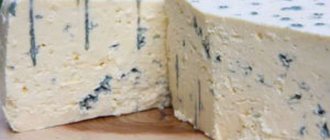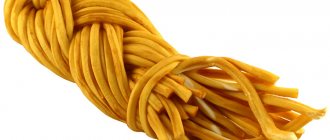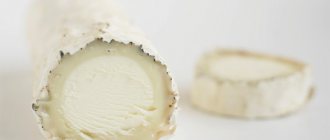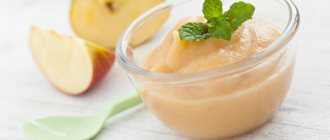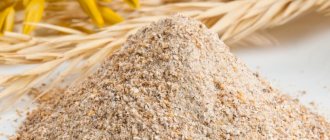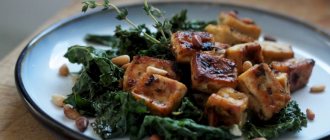Production technology
The peculiarity of preparing a healthy Caucasian product is that it is made from pasteurized milk, heated to 95 0C. Since the cheese does not need to ripen, little time is spent on production. Making Adyghe cheese consists of 5 steps:
- Usually cow's milk is used as a basis. But both sheep and goat will do. It is heated for pasteurization to 95 0C.
- Gradually fermented milk whey is added to the milk. After mixing, the contents coagulate.
- After 5 minutes, the milk clots are carefully collected into a basket made of willow twigs. It is she who “draws” ordinary patterns on the sides of the finished Adyghe cheese.
- The basket is turned over, creating a future cylinder.
- The final stage of production of healthy Adyghe cheese is sterilization. In order to preserve the beneficial properties, taste and quality, a certain amount of salt is added to the product. Then leave it for storage in a cool and dark place for 24 hours.
The result is an elastic head. The taste is pleasant and delicate.
Composition and calorie content of Adyghe cheese
The beneficial properties of Adyghe cheese are determined by the components of which it consists. To prepare it you will need:
- any purchased milk;
- serum;
- table salt.
With a high nutritional value, Adyghe cheese is considered low-calorie. One piece weighing 100 g contains:
- carbohydrates – 1.4 g (mass fraction 1–2%);
- proteins – 18.9 g (59%);
- fats – 15.9 g (40%).
The calorie content of Adyghe cheese per 100 g is 225 kcal. In addition to these useful components, Adyghe cheese is filled with amino acids, vitamins and other nutrients.
List of vitamins with percentages depending on the required amount per day:
- A (25%) improves vision and fights retinal diseases;
- B2 (16.8%) is beneficial for growth and the thyroid gland;
- B3 (23.9%) dilates blood vessels;
- B6 (9.8%) improves metabolism;
- B9 (9.5%) has a positive effect on the circulatory and immune systems;
- B12 (19.5%) is needed to prevent the development of anemia;
- H (8.6%) is responsible for the metabolism of carbohydrates, proteins and fats in the body;
List of useful substances with percentage of the required norm per day:
- calcium (50%) is responsible for bone strength;
- magnesium (6.2%) is involved in the conduction of nerve impulses;
- sodium (36%) is needed to prevent dehydration;
- phosphorus (44.5%) takes part in the process of bone formation;
- zinc (30%) promotes the production of anabolic hormones, improves the functions of the reproductive system;
- copper (6%) is responsible for proper bone growth.
The protein in the composition is easily digestible, and thanks to amino acids, Adyghe cheese is considered very healthy. And if a person is allergic to cow's milk, the product can be made from something else. The recommended daily intake of healthy Adyghe cheese is 80 g per day.
Composition of Adyghe cheese:
Vitamins:
| Vitamin: | IN 1 | AT 2 | AT 4 | WITH | A | D | RR | E |
| in mg. per 100 grams | 0.04 | 0.3 | 0.0 | 0.2 | 0.2 | 0.006 | 5.7 | 0.3 |
Minerals:
| Mineral: | Calcium | Phosphorus | Magnesium | Potassium |
| in mg. per 100 grams | 520 | 360 | 25 | 70 |
It will benefit everyone, but it is especially useful for children, women during pregnancy, nursing mothers, and the elderly. The abundance of such a mineral as calcium in it promotes the rapid restoration of bone tissue, therefore the Adygei cheese variety is indicated for fractures and brittle bones, as well as for people suffering from osteoporosis and tuberculosis.
What are the benefits of Adyghe cheese for the body?
The product is useful for athletes, since the composition is dominated by protein, which is responsible for muscle growth. Recommended for use by pregnant, nursing mothers and children. Adyghe cheese is easily digestible and digestible. The load on the gallbladder and pancreas is minimal. In this regard, Circassian cheese is better than its analogues.
List of useful properties:
- affects the production of the mood hormone, therefore acts as a sedative for the nervous system;
- recommended for those who suffer from hypertension, as it normalizes blood pressure;
- due to the high content of vitamins, it improves well-being, strengthens the immune system and reduces the likelihood of developing cancer;
- improves the functioning of the digestive system;
- responsible for hair restoration, also strengthens nails, teeth, bone and joint tissue;
- has a positive effect on brain function and strengthens muscles.
Adyghe cheese is also useful for men, as it promotes the production of seminal fluid and sex hormones.
During pregnancy
Adyghe cheese is a source of healthy vitamins and minerals. During pregnancy, a woman needs a large amount of them to keep the baby healthy. In addition, just one piece of Adyghe cheese a day will help cope with toxicosis, and the baby will not develop caries.
Contains healthy fats. The fat content of Adyghe cheese allows a woman to replenish her strength, and her body receives nutrients. And since Circassian cheese is made from pasteurized milk, there is no risk of becoming infected with the dangerous bacterium that causes listeriosis. What cannot be said about other types, so for expectant mothers the benefits of Adyghe cheese are obvious.
Attention! To be sure of the safety of the product and retain all the beneficial properties, it is enough to make it at home with your own hands. In this case, you yourself will be able to control the creation process from start to finish.
You should not eat Adyghe cheese if you have gastritis, colitis and urolithiasis.
When breastfeeding
There is no thirst after eating cheese. Swelling does not appear, and milk is produced in sufficient quantities. It is recommended to eat cheese as a component of another approved dish, and not in its pure form. For example, it can be chopped and added to a vegetable salad.
If a child shows signs of an allergic reaction to Adyghe cheese, then he will have to give it up for a month, or even more. In this case, it is better to consult a doctor. You should not use the product if you have kidney disease, gastrointestinal tract or high blood pressure.
For children
You can give healthy Adyghe cheese to a child closer to the age of one year, or, more precisely, in the eleventh month. The daily norm is 5 g. The product is introduced gradually, and it is necessary to monitor the reaction of the child’s body to see if there are any signs of allergies. As they grow older, the daily norm increases; by the age of two, you can give children 30 g of healthy cheese.
Important! You should not feed your children this product every day. 3-4 times a week will be enough.
The ideal time to consume cheese is before lunch. Then the digestive enzymes are most active. You can combine the product with vegetables or pasta (pasta), with bread. Then a balance will be achieved in the intake of fats, proteins and carbohydrates (Adyghe cheese contains very little of these substances).
Adyghe cheese - calories
Classic brine Adyghe cheese is made from two types of milk - cow's and sheep's, but most modern production uses only cow's milk, which affects the taste but does not change the usefulness of the product. The historical homeland of this cheese is the Caucasian region of Adygea. Since Adyghe cheese is often included in diets, the calorie content of this product is of interest to many who want to lose weight.
How many calories are in Adyghe cheese?
The calorie content of Adyghe cheese is 240 kcal per 100 grams. This energy value is typical for the classic recipe: milk is curdled and placed in a mold to drain the whey, then the finished product is packaged and sold. This Adyghe cheese has a delicate texture and a milky, slightly salty taste. The calorie content of smoked Adyghe cheese is higher due to the increase in fat content and amounts to 275 kcal.
Useful properties of Adyghe cheese
The small amount of calories contained in Adyghe cheese is not the only advantage of this product. This soft cheese is valuable for its composition, which includes a large amount of minerals and an almost complete set of vitamins. Among its most useful components are calcium, phosphorus, sodium, potassium, and sulfur.
Due to its high level of calcium, Adyghe cheese is especially useful for children, pregnant women, and those who want to lose weight, because. this element speeds up metabolism and helps shape your figure. In addition, Adyghe cheese improves digestion, has a beneficial effect on the nervous system, improves blood composition, and prevents many dangerous diseases, including heart attack, stroke and oncology.
Adyghe cheese is not recommended only for people with intolerance to dairy products, as well as those suffering from frequent migraines, because it can trigger a headache attack. Adyghe cheese should be consumed to a limited extent if you are prone to swelling, because... it is stored in a strong salt solution.
Adyghe cheese for weight loss
Like many dairy products, Adyghe cheese is very useful for those who want to lose weight. Low calorie and fat content of Adyghe cheese, as well as high protein content, are the most important qualities for dietary nutrition. Another important factor is the versatility of the product. Adyghe cheese goes well with fruit and vegetable salads, fresh herbs, it can be added to soups, baked, fried, made into cheesecakes and various snacks. During a diet, Adyghe cheese helps to compensate for the deficiency of vitamins and minerals.
If you love the taste of Adyghe cheese, try spending fasting days on it. To unload you will need 300 g of cheese and 500 g of fruit - oranges, apples. Divide these foods into 5-6 servings and eat throughout the day. During such an unloading you need to drink water and green tea.
How to choose and store Adyghe cheese?
Adyghe cheese is sold in sealed packaging that prevents air from entering. When purchasing, check the expiration date of the product and the integrity of the packaging. Make sure that the cheese does not have a thick crust. The color of high-quality Adyghe cheese is white or with a yellowish-cream tint. The smell is milky, slight sourness is acceptable.
Since Adyghe cheese is a “living” product, even in sealed packaging it can be stored for no more than a month. Opened cheese should be kept in the refrigerator, wrapped in parchment or foil, so that it does not become saturated with foreign odors and does not dry out. The shelf life of opened Adyghe cheese is 2 weeks, but experts recommend consuming it within 7 days. The shelf life of smoked Adyghe cheese is higher; information about this should be found on the packaging.
Is it possible to have Adyghe cheese while losing weight?
This is the most dietary type of cheese that can be taken by those who want to lose extra pounds. It has high nutritional value and is included in the diet of an overweight person or those who tend to gain weight quickly.
Nutritionists recommend Adyghe cheese for children, athletes, elderly people and hypertensive patients. It is used when recovering from a serious illness or injury. Consuming 100 g of product per day will not affect weight gain; on the contrary, it will help burn extra calories.
Circassian cheese is ideal in combination with:
- fermented milk and dairy products;
- duck, turkey, chicken;
- pasta;
- dough dishes (dumplings, pancakes, pies, khinkali);
- vegetables and herbs;
- fruits and berries;
- nuts, mushrooms and fish;
- buckwheat and other cereals.
Adyghe cheese at home: recipes
We learned the production technology earlier, but we want the product to retain its beneficial qualities when prepared at home. Before making Adyghe cheese at home, it is important to choose one of several recipes and stick with it.
From whole milk
The recipe is classic. To get 1 kg of product you need:
- homemade cow's milk – 7–8 l;
- whey, if you don’t have it, you can use a substitute;
- salt.
Instructions:
- The milk is heated to a temperature of 950C over low heat. There is no need to bring it to a boil, just see the foam on the surface. Otherwise the product will be tight;
- When foam appears, a small amount of whey is poured into the pan around the circumference. If you overdo it with whey, the Circassian cheese will be crumbly and not so elastic;
- the contents are mixed until final folding;
- the lumps are dumped into a container like a colander or gauze. Leave for 20 minutes. During this time, the whey will be removed from the composition, and the contents will be compressed under weight;
- a pressed cylinder is formed from the raw material. Some people add herbs or spices to it;
- the head is lubricated with slightly salted water.
This is how you can get homemade Adyghe cheese from cow’s milk. All that remains is to leave the healthy product in a dark place for a day so that it ripens.
From goat's milk
To make Adyghe cheese from goat milk, you will need:
- goat milk – 2–3 l;
- table salt – 35 g;
- vinegar 9% – 4–5 tablespoons.
Process of creation:
- milk is brought to a boil over low heat;
- 4 tablespoons of vinegar are poured into it;
- the contents are kept on the stove until lumps form;
- they are transferred to a colander with gauze;
- add table salt and mix everything;
- a flat cake is formed with your hands, and to form the desired shape, it is placed in a cast-iron frying pan (dry);
- the contents are kept over medium heat until the mass begins to melt.
After this, the Adyghe cheese is placed in a cold place.
From cottage cheese
The third option is Adyghe cottage cheese. Components:
- cottage cheese – 1 kg;
- cow's milk – 1 l;
- chicken eggs – 3 pcs.;
- softened butter – 100 g;
- soda – 14 g;
- salt – 10 g.
We recommend reading: Baking soda: beneficial properties, uses, how to take
Preparation:
- The milk is brought to a boil, after which cottage cheese is placed in it. The contents should come to a boil again. Leave on the fire for 25–30 minutes, stirring constantly;
- After cooking, the pulp is placed in a colander and the whey is removed from it;
- After decanting, the contents are transferred back to the pan. The remaining components are added and everything is mixed;
- cook for another 10 minutes, during which you also need to stir;
- the cheese mass is transferred to clean dishes, pre-greased with oil or fat.
The mass is leveled and placed in the refrigerator until it cools. It takes about 3 hours.
Peanut calories
Groundnuts are ideal for satisfying hunger before eating ready-made food. A person only needs to consume a small amount of this product to saturate the body and gain a colossal supply of energy . Very often this product is used in a variety of dietary complexes. Nutritionists believe that it is better to eat a handful of groundnuts than to include fatty foods in your diet. In this case, the nutritional value of both the first and second versions will be approximately equal. This product is especially appreciated by people who eat plant-based and dairy foods and avoid meat.
- The calorie content of raw peanuts per 100 g is 548 kcal.
- Protein (complex organic substance, the main component of animal and plant organisms) 26.3 g.
- Fats (organic materials, esterification products of carboxylic acids and trihydric alcohol glycerol) 45.2 g.
- Carbohydrates (organic matter, including a carbonyl group and some hydroxyl groups) 9.7 g.
Fried
Nutritionists recommend frying peanuts, because heat treatment increases their beneficial properties and creates a top protective layer. Due to this, vitamin “E” is not destroyed and the density of antioxidants increases. You need to know that heat treatment (frying) is carried out over the lowest heat without oil and salt.
As for the caloric content of fried peanuts, 100 g contains 608.64 kcal. 100 g of beans contains:
- Belkov 26.9 g.
- Fat 49.8 g.
- Carbohydrates 13.2 g.
To properly roast nuts you need:
- Carefully sort through, remove debris and shells, and select spoiled beans.
- Rinse under running water in a ladle.
- Place the groundnuts on a paper towel to dry thoroughly.
- Pour a small layer onto the heated frying pan.
- When cooking peanuts, do not forget to stir them frequently, and also make sure that the heat is at a minimum. So, the beans will take longer to fry, but this will eliminate the possibility of burning.
- Place the fried beans in the prepared bowl and let them cool. During this time they still arrive.
Salty
As for calories, salted peanuts contain 633 kcal per 100 g (this refers to packaged products sold in stores).
In 100 g of product: proteins 28.9 g, fats 53 g, carbohydrates 11.1 g.
Peanuts with salt are considered not very healthy for the body. It is not recommended for use by expectant mothers - it can cause allergies in the child and people prone to edema. And also with swelling of peripheral veins under the skin (varicose veins), joint disease caused by the deposition of uric acid salts in them (gout) and arthritis.
Peanuts in chocolate
Peanuts in chocolate, the calorie content of which is 580 kcal per 100 g. 100 g of this delicacy contains: proteins 13 g, fats 42 g, carbohydrates 37 g.
Chocolate covered nuts are a sweetness that combines both harm and benefit. The beneficial properties are that this delicacy contains peanuts containing vitamins and minerals under a layer of chocolate. Chocolate can cause harm to a person because it contributes to the accumulation of excess calories in the body .
As a result, obesity occurs. The risk of developing diabetes also increases. Chocolate can also be harmful to a person by increasing allergic symptoms and disrupting the energy balance in the body. It is necessary to consume such sweets in small quantities, and people for whom they are contraindicated should resist the temptation.
Peanuts in glaze
As for the calorie content of sugar-coated peanuts, there are 490 kcal per 100 g of product. 100 g of delicacy contains:
- Carbohydrates 29.1 g.
- Belkov 18.5 g.
- Fat 32.9 g.
To prepare delicious sugar-glazed beans you will need 0.3 kg of peanuts, 8 tbsp. l. sugar and 2 tbsp. l. water.
Sequence of preparing a sweet dish:
- Fry fresh groundnuts in a frying pan without sunflower oil.
- If the peanuts were unshelled, they must be peeled after roasting.
- Dissolve sugar in warm water.
- Mix the beans with the prepared sweet solution and fry in a frying pan.
- Fry until the product is ready (dry).
- At the end of cooking, the dish should have a sugar crust.
What can be prepared from Adyghe cheese
The product is not only healthy, but also very tasty. You can simply eat it in its pure form. Some people prepare fried Circassian cheese or bake it. But they are limited to more than just this:
- make dumplings;
- used for soups and any salads;
- suitable as a savory snack;
- as a filling for khachapuri or pies;
- create cheese sauce;
- as minced meat for meatloaf or poultry;
- pasta, macaroni, porridge with cheese and other side dishes to taste.
In fact, it is a universal, healthy product that goes well with almost all dishes.
Fried Adyghe cheese
The product goes well with butter, so it’s quite normal to fry Adyghe cheese in a frying pan. It turns out delicious, but you need to eat the dish right away. If it cools down, it will be dry and hard. The product practically does not lose its beneficial properties, and when fried it can diversify the diet.
Just cut it into large cubes and heat a frying pan with butter. Circassian cheese is fried until a golden crust forms. Add salt and pepper to taste.
As an option - breaded frying. Then the head is cut into slices up to 2 cm thick.
They are placed in water, breaded and fried in vegetable oil.
Soy cheese Tofu: recipes for its preparation
Tofu can be both hard and soft, which is why it is called both cheese and cottage cheese. It does not have a pronounced taste or smell, but perfectly emphasizes the taste of other products. These features of soy cheese, its high content of vegetable protein, as well as the low calorie content of Tofu made it especially popular in Japan, Thailand, Korea and China.
Dishes of East Asian cuisine that include Tofu cheese (including recipes with soft cottage cheese) are primarily represented by appetizers and salads. Tofu cottage cheese, whose calorie content is approximately 76 kcal/100g, is also added to soup and desserts.
One of the simplest delicious dishes with hard Tofu cheese with a calorie content of about 70 kcal is vegetarian Olivier. For comparison, we note that in comparison with Olivier with Tofu soy cheese, the recipe for salad with meat is designed to prepare a dish with 2 times more calories.
To prepare a vegetarian Olivier with tofu cheese and a calorie content of about 100 kcal per serving (100 g), you need boiled carrots and potatoes, as well as an apple, pickles and mayonnaise. All ingredients must be cut into small cubes and mixed with tofu cheese - the recipe calls for the use of mayonnaise as a dressing. In order to slightly reduce the calorie content of the Tofu , you can replace the mayonnaise with a dressing made from low-fat sour cream and French mustard.
Below we will look at how to prepare another dish - fried Tofu cheese, the calorie content of which is 150-170 kcal / 100 g.
Ingredients for Fried Tofu Snack
- Tofu (firm) - 150 g
- Soy sauce - 1 tbsp.
- Chili pepper - 1 pc.
- Vegetable oil - 1 tbsp
- Chili sauce (hot) - to taste
- Sesame - to taste.
Step by step recipe
- Before preparing fried Tofu cheese according to the recipe, it must be wrapped in a thin cloth napkin (gauze) and placed under a press to remove excess liquid.
Hard cheese Tofu
- While the Tofu is under pressure, cut the chili pepper into several pieces and fry it in a frying pan for a few minutes.
- After this, transfer the pepper to a plate, and add Tofu cut into small cubes into the frying pan and fry it for 4-5 minutes until golden brown. During frying, the cheese must be turned over very carefully so that it does not crumble.
Frying Tofu Cheese
- Then add chili sauce, sesame seeds and soy sauce to the cheese, then fry it for another 2-3 minutes.
Add sesame seeds to cheese
- Ready-made tofu cheese, the calorie content of which is directly related to the amount of sesame added to it (the calorie content of this product is 565 kcal/100 g), can be served either hot or cold.
Selection and storage
Circassian cheese will be healthy and tasty when it is made with high quality. To do this, it is important to choose it correctly. There is a list of criteria that you should pay attention to. The following are highlighted:
- Appearance and color. Ideal - light cream. Slight cream pigmentation is allowed. If there is a crust, then it is stale. Stains, stains and mold are a sign of poor storage;
- Consistency. A high-quality and healthy product will be soft, curdled, and crumble a little. Dry and dense ones are not worth buying;
- Taste. Pleasant, soft, slightly salty. There should be hints of whey protein. A sour or pungent smell and taste is a sign of a spoiled product;
- Package. It indicates the date of manufacture and expiration date. The container must be intact and vacuum sealed. If Adyghe cheese is not smoked, then storage is no more than 15 days.
The product should be stored in a glass container that has a closing lid. It is needed to protect against foreign odors. Some are stored in a container. A little sugar is placed in it to serve as an absorbent. It should be stored in this condition for a maximum of 3 days.
The note! When smoked, it can last for more than a month without loss of quality.
Harm of Adyghe cheese
There are no contraindications for use. Everyone can feel the benefits of Adyghe cheese, unless they are allergic to fermented milk products. Some have noticed one side effect that occurs with excessive use of the product - a severe headache. The reason is the content of the alpha amino acid tryptophan.
Naturally, stale Circassian cheese can also cause harm, causing poisoning and disorder of the digestive tract. The product should not be frozen. In this case, it loses almost all of its beneficial properties, and after defrosting it becomes brittle and crumbles.
The benefits of Adyghe cheese
The following benefits of Adyghe cheese are known:
- the product is considered lightly salted, so it can be eaten with high blood pressure;
- lactic acid bacteria in cheese help restore intestinal microflora;
- Regular consumption of Adyghe cheese ensures cleansing of the body from toxins;
- Due to the presence of tryptophan, cheese is a natural antidepressant - it improves mood, normalizes sleep, increases resistance to stress, and helps cope with anxiety and nervousness.
Reviews
Usmanova Alina, Moscow
I have been buying Adyghe cheese for a long time. It is included in the list of foods used in my diet because it is low in calories. I always take it in a sealed package and keep track of the dates, since my friend got food poisoning after eating an expired product. Review text
Panfilov Victor, Ekaterinburg
I really like the taste of cheese, especially the salty taste. I have a smokehouse, so after cooking using my own technology, I immediately smoke it. This allows the product to be stored longer and the taste improves. I don’t know how healthy it is, but it turns out very tasty.
Osipova Lidiya, Voronezh
I tried it for the first time in a puff pastry. I liked it. We started buying in heads. The child loves to make hot sandwiches. Even the absence of sausage and other ingredients does not scare him. Just bread and cheese. I noticed that I began to grow faster, and I myself became more active. I recommend!
